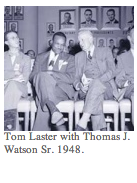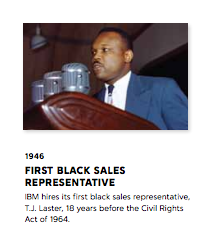Think You Have it Tough? Think How it Feels to Be the First!
As we begin to close out Black History week, I wanted to give you a chance, once again to see what it was like for a true sales pioneer. His ability to deal with racial preference, racial discrimination, and acts of racial prejudice are legendary. We cannot avoid giving kudos to International Business Machines (IBM) in their effort to promote diversity.
_____________
Amazingly enough, it is still not too late to be the first! Being the first is an important role in American society. It is equally important in business.
I am going to use cite one iconic American company as an example. As a matter of fact, it is more than symbolic, because this organization took a leadership role. This is a brief study in how an organization handles diversity.
A Leader in More Ways than One
In 1946 International Business Machines, also known as IBM, hired its first black sales representative. It was an individual named Tom (T.J.) Laster. This was well before the Civil Rights Act of 1963. This act was also well before the Jackie Robinson broke the color barrier in professional baseball. This was not a beauty products company, or someone selling durable goods products to the Black community, this was a business products company that was on the technical leading edge, and selling their product to basic ‘white’ America’s businesses.
professional baseball. This was not a beauty products company, or someone selling durable goods products to the Black community, this was a business products company that was on the technical leading edge, and selling their product to basic ‘white’ America’s businesses.
The audience that Laster was something to was decidedly in the majority. If we think we see racial prejudice and racial preference, we need to recognize that we see nothing like this gentleman was faced with during his tenure as a sales professional. A couple of years later, Laster joined the 100% Club, an honor for reaching his sales quota. This was affirmation to many that this individual was a qualified and accomplished sales professional.
The 40s, 50s, and 60s were decidedly difficult time even dream of being “the first” in B2B sales, but someone had to do it. Soon after Laster, IBM hired their first Black marketing representative (Lionel Fultz) in 1951, their first Black engineer in 1952 (Harry Cochraine), and their first Black engineering manager, (Calvin Waite) in 1956. Lionel Fultz also was named branch manager in 1964.
This made IBM a leader in both business machines as well as employment diversity. It also made Tom Laster a pioneer in the sales diversity situation. He was willing, and obviously began destroying the racial perceptions that Blacks, or Negros as we were referred to in that time, could not handle the technical nature and business relationship issues related to B2B sales to a white business populace. I would believe that partially as a result, many others Black professionals followed through the doors that were opened.
There was no greater a threshold in business sales as this one! This was certainly important. Although you probably won’t read books about it there is no doubt as to the impact.
Following this, IBM, assuming the leadership role again, penned and enacted its Equal Opportunity Policy through the Thomas Watson’s (the president of IBM) letter to his organization termed as Policy Letter # Four. This September 21, 1953 letter directed his managers to “…hire people regardless of race, color, or creed.” We wish it was as easy this declaration, but this was a start.
This is Significant, But Why is it Important?
I hope you see the significance in the story of Laster. He is truly a pioneer, and really knows what it feels like to be the first. What is equally important is that you still can be the first Black sales professional in many organizations.
By the same token, you still can be that individual the changes everyone’s ideas about the abilities and work ethic of black professionals. It would be nice not to worry about that, but it is significant.
I was not the first Black sale professional in the organization that I came up in. I was actually the third. I was the first Black sales manager, and the first Black vice president, senior vice president, and executive vice president. I had some interesting experiences, which I try to share in this ‘journal’, but I am certain that many of these assertions would have paled in comparison to the stories that Laster could tell.
Be the Best
There are many small and medium sized organizations that have avoided, for whatever reason, employment diversity. They could have avoided it because of their small size, or because they purposely have not hired Black sales professionals. They may have other Blacks and minorities working for the company. It does not matter what the reason might be, embrace that opportunity to work for and to change those organizations. Show your stuff!
Your only requirement is to do be best that you can be at what you do. By being the best, you increase your opportunities for success, as well as destroy ridiculous and erroneous racial perceptions. Your success will be rewarded with a high compensation rate, but also in the pride you have in being the first!
Be the Best! Your comments are appreciated.
 February 24, 2014
|
Posted by Admin9!
February 24, 2014
|
Posted by Admin9!

 Categories:
Categories:  Tags:
Tags: 

Your Comments